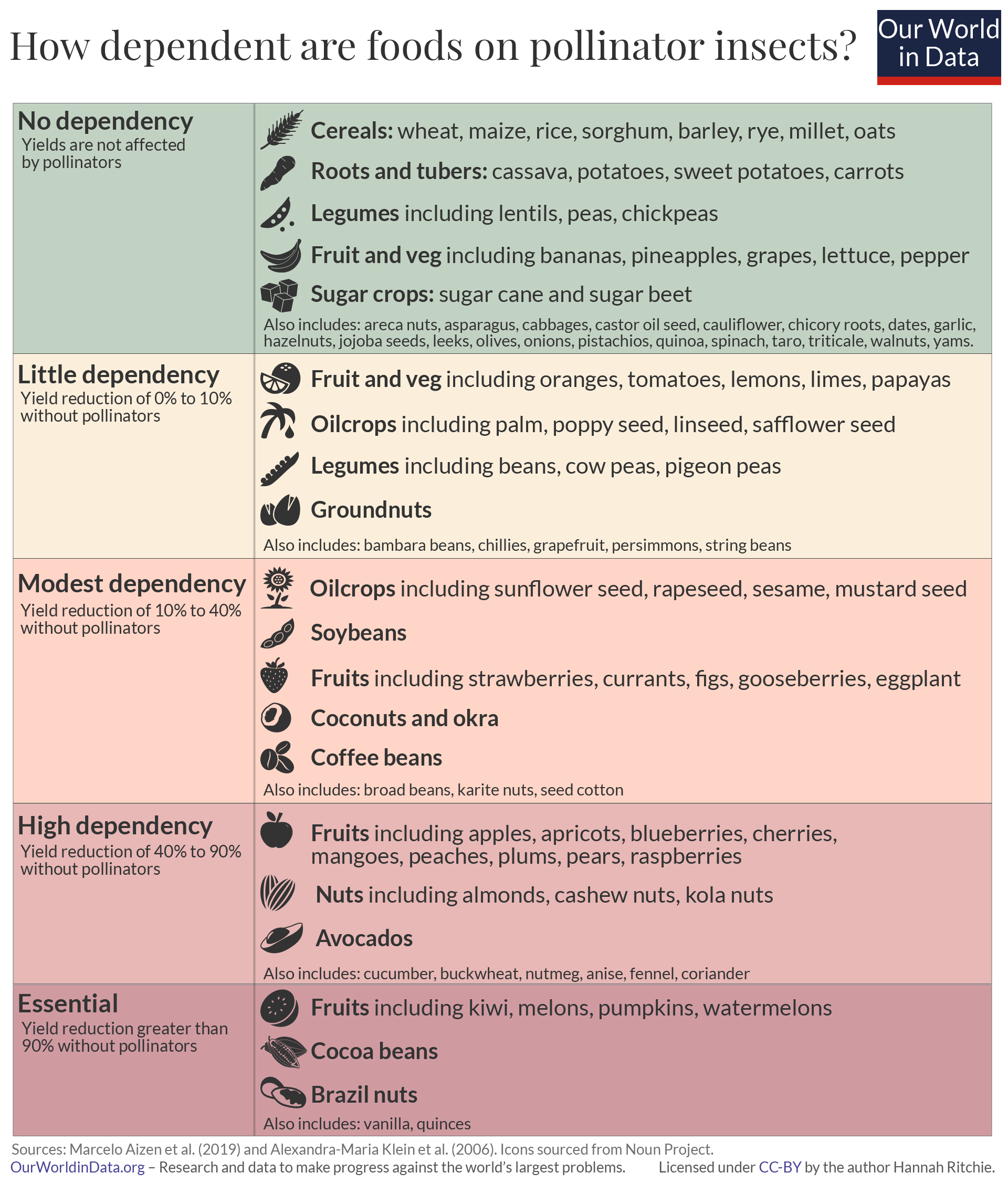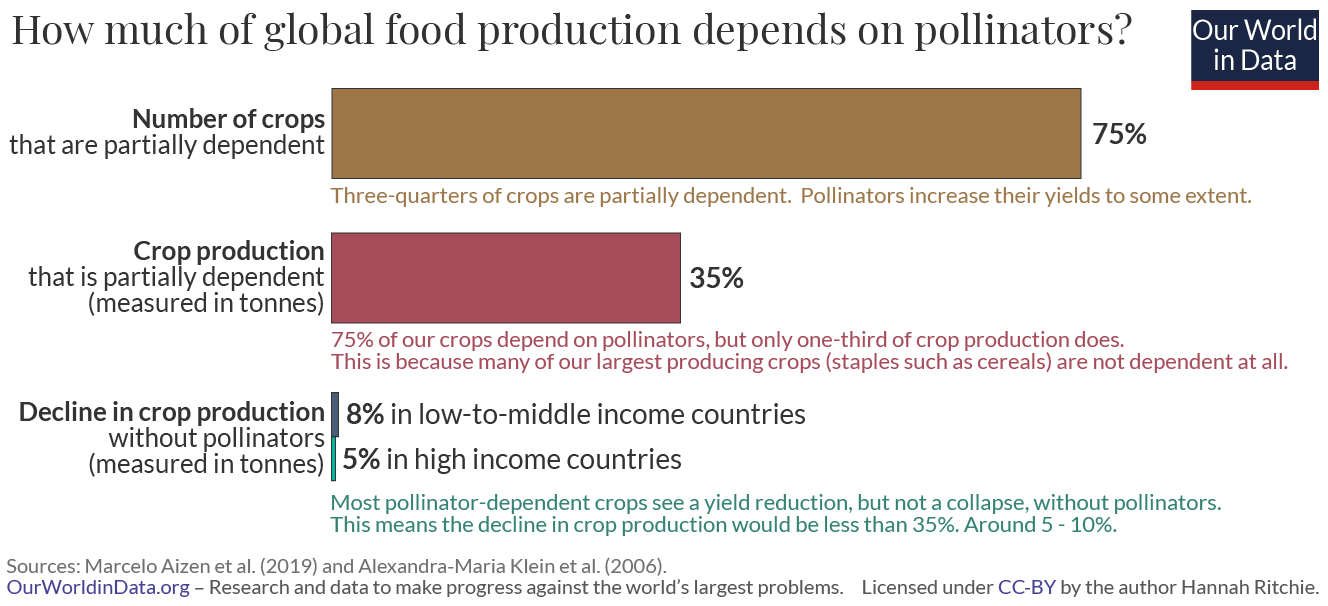Summary
The populations of many pollinator insects – bees, wasps, and butterflies – are in decline. Many crops rely on pollinators which raises concerns about the future of our food.
Three-quarters of our crops depend on pollinators to some extent, but only one-third of global crop production does. This is because many of our largest producing crops (staples such as cereals) are not dependent on them at all.
Very few crops are completely dependent. Most would see a decline in yields if pollinator insects disappeared, but would not collapse completely. Taking all this in account, studies suggest crop production would decline by around 5% in higher income countries, and 8% at low-to-middle incomes if pollinator insects vanished.
It’s unfortunate that the wildlife we care least about provides us with the most functional value. We favor the bears over the insects and bacteria, despite relying on the latter much more.
There is nowhere that this is more obvious than food production. Pollinator insects – bees, wasps, beetles, flies, ants and butterflies – play an important role in agriculture.1 We might associate crop pollination with honey bees, but a range of studies have shown that non-bee pollinators (such as butterflies, beetles and hoverflies) also play an important role in the pollination of fruits, vegetables, and oilcrops.2 Many people worry about the stability of our food systems as more studies suggest that the world’s pollinator insects are disappearing.
Many recent studies report a decline in insect populations in different regions. This is not the case everywhere – some species are stable, and some have actually increased – but most show an overall decline. A study in the Netherlands reported that average butterfly populations had almost halved since 1991.3 The European Environment Agency measured changes in grassland butterfly populations across 17 species and 17 countries.4 Since 1991, average populations have declined by around 25%. The same is true of bumblebees: numerous studies across Europe and North America show that, while some populations remain stable or are even growing, many bee populations have seen a steep decline.5 That’s just for richer countries, where agricultural systems have been relatively stagnant for decades. Where ecosystems are changing the most rapidly – across the tropics – we have very little data on how pollinator insects are changing. They could be doing even worse.
Pollinator insects face multiple threats.6 One is simply habitat loss: the area they can live in shrinks as human land use for farming and infrastructure expands. Another is climatic changes: they can be particularly vulnerable to intense drought. A single year of intense drought in the UK in 1976 resulted in a dramatic decline in butterfly populations. Populations of some butterfly species fell by 76%.7 There are also threats on agricultural lands when we use pesticides and fertilizers to increase crop yields.8 This presents us with a dilemma: some of the ways we can increase food production might also put it at risk.
That raises an important question: how dependent are we on pollinators? What would happen if pollinators decline dramatically, or worse, if they disappeared?
What crops are dependent on pollinators?
There are two things that are important to clarify. First, not all crops are dependent on pollinators. Many of our staples are completely unaffected by them. Second, if a crop is defined as being pollinator-dependent, this does not necessarily mean that it would fail without them. In fact, there are only a couple of crops where pollinator insects are essential. For all others a decline in pollinators would result in a decline in yields.
Researchers differentiate crops into categories using a scale of pollinator dependence. This ranges from having no dependency, to pollinators being essential. Between these extremes is ‘partial dependency’: pollinators increase their yields. The table shows us what crops fall into each category.9
Most of our staple crops – cereals such as maize, wheat and rice; roots and tubers such as cassava; and legumes such as peas and lentils – do not rely on bees and butterflies at all.
A lot of our fruits and vegetables, oilcrops, coffee, nuts and avocados are partially dependent.
There are only a few crops that are fully dependent: brazil nuts, fruits including kiwi and melons, and cocoa beans. A world without pollinators would mean a world without chocolate.

How much of the world’s food production depends on pollinators?
With this background we can better-understand the role that these insects play in our food production. We can also navigate the numbers that often hit the headlines on this topic.
The numbers we need to understand are shown in the chart.
Many reports – including those from the UN Food and Agriculture Organization (FAO) quote the figure that “75% of our crops” rely on pollinators. It’s true: around three-quarters (75%) of the different crops we grow for food depend on pollinators to some extent. This is based on the number of different crops. This is the top bar in the chart.
But, we grow very different amounts of these crops. We harvest much more wheat and rice than strawberries and apples. When we calculate how much of our food production (in tonnes10) comes from pollinator-dependent crops, it’s much lower: around one-third of our food production (35%) relies on pollinators.11
Finally, as we just discussed, most of these crops are only partially dependent on pollinators. Their yields would decline, but they would not fail to grow. When we account for this, researchers estimate that crop production in high-income countries would fall by around 5%; in low-to-middle income countries this would be 8% in the absence of pollinators.12 These figures come from a study a decade ago [the latest study available] – today, they might be slightly higher. I would think it might be 10% by now. This is because the world has become slightly more dependent on pollinators over time.13

Pollinator-dependent crops tend to be important cash crops for farmers
This figure of 10% might seem low. But there are a few things we should keep in mind.
Our dependence on pollinators will probably grow over time as global diets diversify. As countries get richer they tend to shift away from staple crops towards fruits, vegetables, nuts and other nutrient-rich foods.
It’s also important to consider not only the amount of food that would be lost, but also the amount of income that could be lost. This is especially true for low-income farmers. Many of the crops that are dependent on pollinators – cocoa, coffee, soybeans, palm oil, avocados – are cash crops that many lower-income countries rely on for trade. A steep decline in pollinators might not see a dramatic change in the world’s production of calories, but it could hit some of the world’s poorest economically.
This leaves us with a delicate balance to navigate. We want to achieve high crop yields. This is not only important for food security and farmer incomes, but also brings important ecological benefits: it means we need less farmland and we can spare habitat for wildlife. The catch is that achieving high crop yields often requires some agricultural inputs such as fertilizers or pesticides; inputs that could potentially reduce pollinator populations. A decline in pollinators would in turn, reduce yields.
Moving forward we therefore need to focus on agricultural practices that can do both: maximise yields and preserve pollinator biodiversity at the same time. This needs a better understanding of what agricultural inputs affect pollinator populations, and whether there are particular management practices – such as specific timings or application rates – that can limit the damage to insect populations. Balancing both is key for biodiversity on and off the farm: maximising yields with pollinators present would save surrounding habitat from being turned into farmland, allowing wildlife to flourish.
Acknowledgements: Many thanks to Max Roser for the invaluable feedback and suggestions on this work.